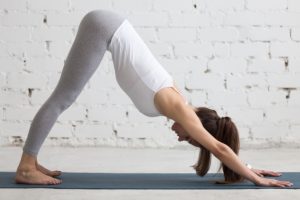
IBS patients suffer from gastrointestinal and digestive symptoms, such as constipation, stomach cramping, bloating, and diarrhea. Yoga can ease digestion in two ways. First, it helps reduce stress, as it can wreak havoc on your digestive system. There is a higher risk of constipation during times of stress.
Secondly, yoga’s twisted and inverted poses offer a gentle massage for your digestive system, increasing the blood flow and oxygen delivery.
Rachael Weiss from The Playful Yogi explained, “People who are very bloated, have distended bellies, or just have a little extra body fat around the middle may find twists extremely challenging or uncomfortable. My rule of thumb is, if it is painful, don’t do it. A little discomfort is okay, as long as it is not painful. If you struggle with twists, consider sticking to supine twisting — on your back — or seated twists.”
Other benefits of yoga for IBS patients include reducing the likelihood of weight gain, which is a common occurrence in IBS, and reducing the triggers of diarrhea.
Research studies on the topic have also revealed that yoga is a viable treatment option when dealing with IBS, too. One study measured the effects of yoga on gastrointestinal symptoms in IBS patients. Those who practiced yoga, either in the class setting or at home experienced less anxiety, avoidance behavior, and disability, compared to those who were on a wait list (control group).
Another study focused on men who had diarrhea-predominant IBS. Some of the participants received medication, while the others partook in yoga. The yoga group practiced 12 poses twice a day. After two months, although both groups saw reductions in their symptoms, the medication group saw an increase in gastrointestinal activity, while the yoga group had greater activation of the part of the nervous system that is involved with calming the body.
As you can see, yoga is a safe and effective way in managing IBS-related symptoms and can easily be practiced in the comfort of your home or at a studio.
Yoga poses for irritable bowel syndrome
Parighasana (Gate pose): Kneel on both knees and then extend one leg out to the side with your heel on the ground. Inhale, lift the opposite arm of the extended leg, and lean over to your side with your other hand resting on your calf. Hold this for a few breaths, return to center, and switch sides.
Ardha matsyendrasana (Half-seated spinal twist): Sitting on the floor upright, keep one leg straight out in front and have the other knee bent, foot on the floor. Cross the bent leg over the straight leg. For example, if your left leg is stretched out, your right foot will be on the outside of your left knee. Now bend the straight leg so the heel of your foot comes towards your buttocks. Gently twist your torso in, so that you are looking to the side of your outer thigh. Hold this position and switch legs.
Jathara parivritti (Reclining abdominal twist): Lay on your back with legs out straight. When you exhale, bend the right leg and hug it into the belly. Now carry over the right knee over your left thigh and extend your right arm outward away from the body. Take a few breaths, return to center, and switch sides.
Salamba setu bandhasana (Supported bridge pose): Use a stack of towels or blankets to support your lower back. Place this beneath your hips as you lay flat. Keep hands out by your side, palms up, and feet forward.
Ananda balasana (Happy baby pose): On your back, bring your legs up into the air with knees bent as if you are hugging your knees to your chest. Then try to grab either your big toes or the soles of your feet. Shoulder blades should be relaxed into the ground. If possible, rock gently side to side.
Marjariasana (Cat pose): On hands and knees, curl your spine so that your abdomen is tucked in and breathe for a few breaths. Then release and arch your back with head pointing upward, and breathe in this pose. Switch between a curved spine and an arched spine, moving gently.
Pavanamuktasana (Wind-relieving pose): Lay on your back, hug your knees to your chest, and hold.
Adho Mukha Shvanasana (Downward-facing dog pose): With feet flat on the ground, fall forward to place your hands on the ground. Your buttocks should be high in the air and you should be in a triangle position. If you can’t get your feet flat, you can rotate. Step easily stretching your calf muscles and working towards flat feet.
Bhujangasana (Cobra pose): Laying on your stomach, place hands on either side of your chest. Now raise your chest slowly while arching your back. Hold this position for a few breaths.
If you’re new to yoga, you can join a local class in your community, purchase some DVDs, or watch online videos. Always remember to breathe through your movements in order to prevent injury. With regular practice, not only will you improve your flexibility, but you will see improvements in your IBS symptoms, too.
Related: 5 yoga poses to strengthen your bladder